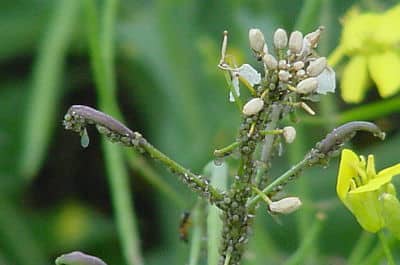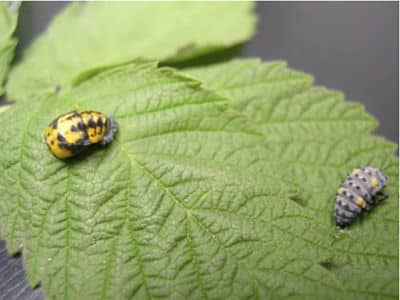Lygus. Some Alberta fields have had 6-8 adults per 10 sweeps in the past week. Any field getting 0.5 to 1 lygus per sweep at early flowering should be monitored closely as it comes out of flower. Those numbers at early flower mean the next generation of lygus that comes out at the podding stage is more likely to be at damaging numbers — as long as weather conditions (warm and fairly dry) favor buildup. At the pod stage, counts of 8 or more per 10 sweeps can be enough to trigger a spray at today’s prices. If we continue to get bands of showers, lygus populations will likely decline.
Diamondback moth. Adult counts in traps are generally low — except in eastern Manitoba. As fields come out of flower and are podding, growers in areas with high counts need to scout aggressively to assess the threat of damage from larvae.
Slugs. Slugs are feeding on canola plants in a few fields in Alberta. The situation is not widespread but causes anxiety for those few growers. There is no registered product to control slugs in canola. Metaldehyde is a molluscicide registered for slugs in vegetable gardens and ornamentals. However, even in high value vegetable crops, control is considered too expensive on a large field scale. Aside from drier conditions, one long-term management consideration for fields with high slug counts could be tillage, but that is not proven and does not provide a remedy for this year’s canola crop.
Cabbage seedpod weevil. The weevil is at thresholds in pockets of southern Alberta, but numbers are down from previous years. In southwest Saskatchewan, counts are not near economic threshold. The highest recorded count in Saskatchewan is 12 adults in 10 sweeps (or 1.2 per sweep, on average.) At prices over $8 per bushel, an average of 2 to 3 weevils or more per sweep is the recommended economic threshold.
Scott Meers of Alberta Agriculture & Rural Development is recruiting scouts and crop consultants to enter cabbage seedpod weevil data into an online survey. This data will populate a google map that will show weevil hotspots in real time. Call 310-2777 (only in Alberta) and provide name, sample date, location (LLD or GPS), total number of sweeps, and total number of weevils in those sweeps.
Bertha armyworm. Adult moth counts were elevated in some areas in northwest Saskatchwan. Entomologists do not anticipate a big issue with bertha this year. Generally the peak emergence of the moths is about the middle of July so it will take a couple more weeks of monitoring to completely rule out the threat.
Root maggots. Plants are toppling over in some fields in central Alberta. Growers think disease is the cause, but when they pull up a plant they find the roots full of maggots. There are no effective control options in crop, but growers should note these fields as they plan cultural control strategies for next year.
Aphids. Thirty to 40 per plant have been spotted in a canola field near Elie, Manitoba. This is a rare event. Aphids, if they do appear in canola, tend to cluster on a few plants here and there within a small pocket of the field. Turnip aphid is the one species that will feed on canola bud clusters. (See the top photo, below.) Those are the ones you have to be concerned about. If 10% to 20% of stems have aphid clusters around the flower buds and if this is spread over a large enough area, then a spot spray of that area may be warranted. Dimethoate (Cygon and Lagon) are registered for aphid control in canola. Look for lady bug larvae and adults before spraying. (Bottom photo, below.) Lady bugs eat a lot of aphids and can keep populations from escalating, but keep watching. Aphid numbers can explode quickly.

